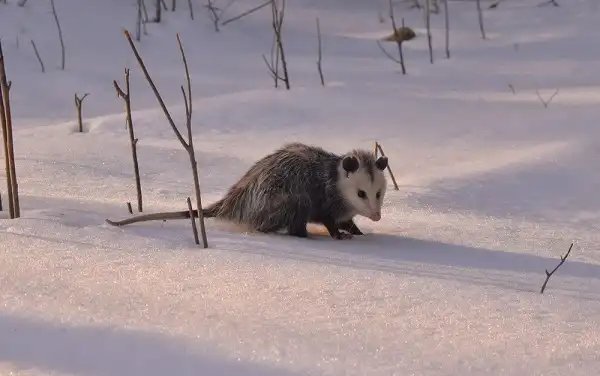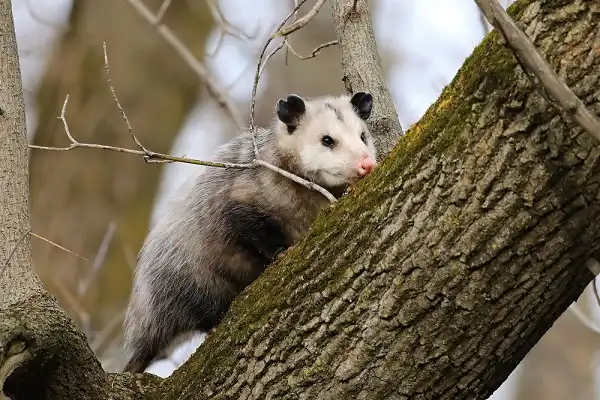Do you know about opossums? Most people think of these small marsupials as scavengers, or as animals that are only present in the dead of night. However, there is much more to a possum than most people realize! In this blog post, we’ll dive into the fascinating world of the common opossum and explore its diet, behavior, and habitat. If you’ve ever been curious about what exactly an opossum is, or why they hang by their tail from tree limbs for hours at a time then read on!

Opossum Description
Opossums are small marsupials. They have a long, slender snout connected to a pointy nose, as well as large ears that help them hear better. The fur on an opossum can be gray or brown with white accents, and the tail is usually black or dark until the tip, where it turns white. The common opossum has an omnivorous diet consisting of fruits and vegetables, insects, and small animals like rodents. They will also take advantage of human food sources such as garbage cans if given the opportunity! Opossums are also known to eat carrion (dead animals).
Opossum Habitat
Opossums can be found throughout the Americas, living and thriving in diverse habitats. From humid rainforests to arid deserts, these adaptable creatures make their homes in a variety of places. In urban areas, opossums may take refuge beneath decks, sheds, and other structures; in rural locations, they may inhabit burrows dug by other animals or nest in hollow trees or logs. Opossums are also known to occupy abandoned buildings and attics. The common opossum is an opportunistic feeder that requires access to both ground-level vegetation as well as some sort of shelter. This means that they often live near bodies of water since it provides them with the vegetation they need and protection from predators. Additionally, opossums are very good climbers and will often use tree branches and limbs for sleeping during the day, foraging at night, or when avoiding danger.
Opossum Diet
The common opossum has an omnivorous diet consisting of a variety of diverse sources. This includes fruits, vegetables, nuts, insects, small animals such as mice and rats, eggs, earthworms, frogs, carrion (dead animals), and even some human food sources like garbage or pet food. Opossums have also been known to feed on fruit-bearing trees such as apples and cherries. Additionally, they will consume decaying organic matter like mushrooms and snails if they come across it. Opossums are opportunistic feeders which means that they will take advantage of whatever food source is available during the time. This helps them survive in multiple different habitats with varying levels of resources. It is important to note that opossums do not hibernate during winter months and thus must find other ways to stay nourished through cold periods. In urban areas where food may be harder to come by, opossums rely heavily on human sources such as garbage cans or pet food bowls left outside overnight.

Opossum Size
The common opossum can range from 11 to 37 inches in length and weigh from 1 to 14 pounds. Opossums are generally considered medium-sized mammals but there is some variation depending on the species. For instance, Virginia Opossums (Didelphis virginiana) may reach lengths of up to 40 inches while Pouches (Philander opossum) are much smaller at only 8 to 10 inches long. Additionally, Northern Opossums (Didelphis marsupialis) tend to be heavier than their Southern counterparts and can weigh up to 20 pounds! Despite their small size, opossums have powerful claws that allow them to climb trees easily and hang by their tails for hours at a time if needed. They also have opposable thumbs on their hind feet which helps them pick up food items or hang onto tree branches.
Opossum Lifespan
The common opossum typically lives for 2-4 years in the wild, however, some have been known to reach up to 7 years. In captivity, with proper care and nutrition, these animals can live for up to 10 years. The average litter size is 6-8 babies and females can reproduce as soon as 3 months old. Opossums are one of the few marsupials that are able to go into a state of torpor during cold spells or periods of starvation, which helps them survive when food is scarce. This state helps them conserve energy and slows down their metabolism so they require less sustenance than other mammals of similar size. Despite the fact that they are generally solitary creatures, opossums do socialize with other opossums when necessary. This includes mating rituals as well as raising young together in communal nests. Furthermore, female opossums have a unique ability to delay implantation so if resources become scarce the mother may choose not to give birth until conditions improve. Overall, opossums are resilient creatures that are capable of adapting to different environments and finding food sources where none seem available. They play an important role in controlling rodents and other pests as well as scavenging dead animals that could spread disease otherwise. As such, they help maintain balance in ecosystems while also providing humans with hours of entertainment due to their often comical behavior!
Opossum Behavior
Opossums are generally nocturnal creatures who spend their nights foraging for food, although they may be active during the day if resources are scarce. They tend to be more solitary animals but will cooperate and even form temporary social groups when necessary. When threatened, opossums will usually attempt to flee or play dead, a behavior is known as “playing possum”. This involves releasing an unpleasant odor from its anal glands while slumping over with its mouth slightly open and its tongue hanging out. This can last anywhere from a few seconds up to several minutes until the danger has passed. When it comes to communication, opossums rely on several methods including scent marking, vocalizations such as hisses, whines, or growls, and physical gestures such as showing teeth or fur standing on end. They also use body language to express fear or aggression such as flattening their ears or tails against their backsides. In terms of mating behavior, male opossums will court females by vocalizing in a sort of purring sound to attract potential mates. Females generally give birth to litters of 6-8 young after about 12 days of gestation. The young are born blind and helpless and must find their way into the mother’s pouch where they feed on her milk for two months before venturing out into the world. All in all, opossums have fascinating behaviors which have enabled them to survive in some of the harshest environments on earth!

Opossum Speed
Though they may seem slow, opossums are actually quite fast creatures. They can run up to 15 miles per hour making them much quicker than cats or dogs. Additionally, opossums have an impressive ability to climb trees which helps them escape from predators as well as find food such as insects and bird eggs in the upper branches. Opossums also have remarkable agility for their size and can jump 4-6 feet into the air or make tight turns when fleeing danger. Their flexible joints and long tails help them balance while running at top speeds and ensure that they can reach safety quickly if needed. This is especially helpful in urban areas where there are many potential threats such as cars or people. Overall, opossums possess impressive speed and agility which helps them survive in the wild. Their combination of quick reflexes and flexible joints make them adept climbers who can navigate their environments with ease. So even though they may seem slow at first glance, these creatures are actually quite capable when it comes to running and jumping!
Opossum Hunting
Opossums are formidable hunters who have adapted to survive and thrive in many different environments. Their omnivorous diet consists of both plant matter and animal proteins such as insects, birds, rodents, snakes, eggs, carrion, and even fish! They search for food by sniffing the ground and poking their noses into crevices or burrows. The opossum’s sharp vision allows them to detect motion up to 50 feet away and they will often stalk their prey before pouncing on it with remarkable speed. Their agility helps them maneuver quickly while their claws aid in digging up food or capturing small animals. They also use their prehensile tails as an extra limbs to help secure items while climbing or carrying food back to their nests. In addition, opossums have several other adaptive hunting behaviors like vocalization which can be used for communication and intimidating predators. They also use a “fright response” technique which involves hissing, growling, drooling from the mouth, and exposing teeth as a way of deterring potential threats.

Conclusion
The opossum is a remarkable creature that has adapted to live in many different environments. They possess impressive speed and agility which makes them adept climbers who can navigate their environment with ease. Additionally, they make skillful hunters with sharp vision and vocalizations used for communication and intimidation purposes. Their remarkable behavior has enabled them to survive in some of the harshest conditions on earth. So next time you see an opossum ambling along, take a moment to appreciate the fascinating abilities of this unique animal!
Frequently Asked Question


